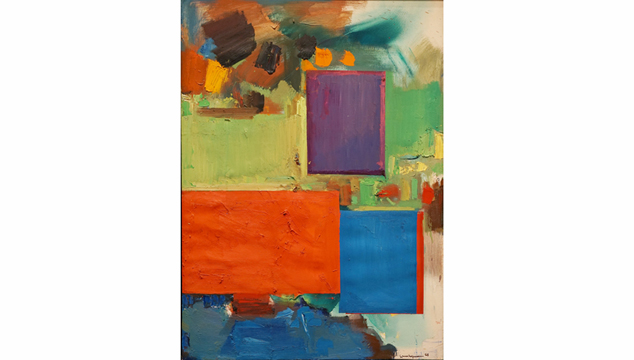
When I first saw the painting “Rhapsody” by the abstract expressionist painter Hans Hofmann, I immediately liked the brightness and variety of the colors and forms. As I studied it, I saw that this painting affected me because it answers some of the deepest questions of people’s lives—of my life. I think “Rhapsody” and why I like it so much is explained by this great Aesthetic Realism principle, stated by Eli Siegel: “All beauty is a making one of opposites, and the making one of opposites is what we are going after in ourselves.”
Two opposites that fought in me all my life and that trouble many people are brought together in this painting: the exuberant and the sensible. Webster’s Dictionary defines exuberant as “joyously unrestrained and enthusiastic… overflowing…lavish,” and sensible as “…containing sense, judgment, reason.” Can we be all these things at once? Can we be excited and reasonable at the same time? Aesthetic Realism says we can, and that we can learn from art how to be.
In his book, Self and World: An Explanation of Aesthetic Realism, Mr. Siegel asks this revolutionary question, “What is it that painting—coming from the human mind—can do which the human mind itself can’t do? A person can ask about a picture, What has it got I can’t have?”
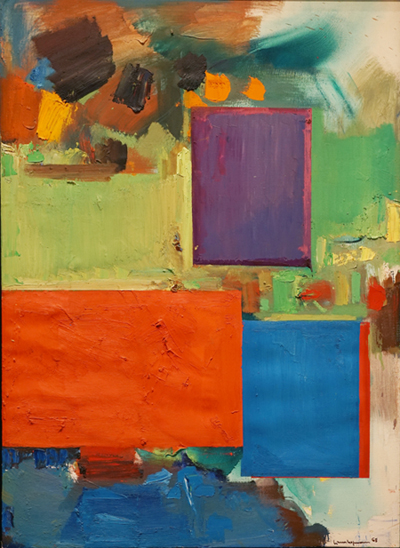 The actual size of “Rhapsody” is over 7’ high by 5’ wide. The first thing you see are those three big rectangles: red-orange, blue and purple. One is horizontal, two are vertical. Then, all around them is something looser, freer—patches, strokes and areas of orange, green, yellow, black, red and blue. I like the roughness and energy of the brush strokes.
The actual size of “Rhapsody” is over 7’ high by 5’ wide. The first thing you see are those three big rectangles: red-orange, blue and purple. One is horizontal, two are vertical. Then, all around them is something looser, freer—patches, strokes and areas of orange, green, yellow, black, red and blue. I like the roughness and energy of the brush strokes.
What Mr. Siegel asks in the first of fifteen questions in his historic publication “Is Beauty the Making One of Opposites?” is at the heart of this exciting painting:
Freedom and Order—Does every instance of beauty in nature and beauty as the artist presents it have something unrestricted, unexpected, uncontrolled?—and does this beautiful thing in nature or beautiful thing coming from the artist’s mind have, too, something accurate, sensible, logically justifiable, which can be called order?
The rectangles are very orderly, they are “accurate” and “sensible.” A rectangle is a logical geometric shape—four sides, four right angles, each pair of sides parallel to the others. Yet all around them is something “uncontrolled,” “unrestricted,” something much freer, and we feel these two things go together, complete each other, even as they are so different. Hofmann’s painting shows we can be swept and sensible, free and accurate at once.
I Was Not Like This Painting
In my own life the way I went for being orderly and sensible was against freedom and honest exuberance. I liked to have things around me very neat—my apartment and my desk. But more importantly, I liked to have what went on inside of me, my emotions and feelings, manageable and orderly. The title of this painting is “Rhapsody” and I was afraid to have feelings like that, emotions that seemed out of my control. I thought if I got too excited I would lose all sense of myself as logical and having my feet on the ground. But I suffered because I often felt flat and didn’t have the kinds of feelings everyone wants to have, for instance about another person, or about a work of art such as this one.
As an actor this held me back, too. In a class for Aesthetic Realism consultants and associates, Chairman of Education, Ellen Reiss spoke to me about my work as an actor and asked: “Do you think in some way you could let go more?” That question had my whole life in it, and I’m grateful to Ms. Reiss and Aesthetic Realism for what I’m learning, making it possible for me to have feelings about art, about people, that I never had before. I’ve been learning the meaning of what Eli Siegel writes in Self and World: “Beauty is good sense. It is hard good sense.”
What Hofmann’s painting “Rhapsody” does is completely different from the purpose I had in my everyday life. I dulled the vibrant meaning of things which is contempt, and because of this I felt half alive. Then I began to study Aesthetic Realism and I’ve never had that feeling of being half alive since. What I’ve learned has changed my whole life in such a beautiful and deep way, enabling me to have large feeling, and very much for my wife, Meryl Nietsch-Cooperman.
All art, I learned, goes for finding meaning in things, not flattening them. I think Hans Hofmann is proud to show he is excited—his painting is not muted. He is both accurate and free at once.
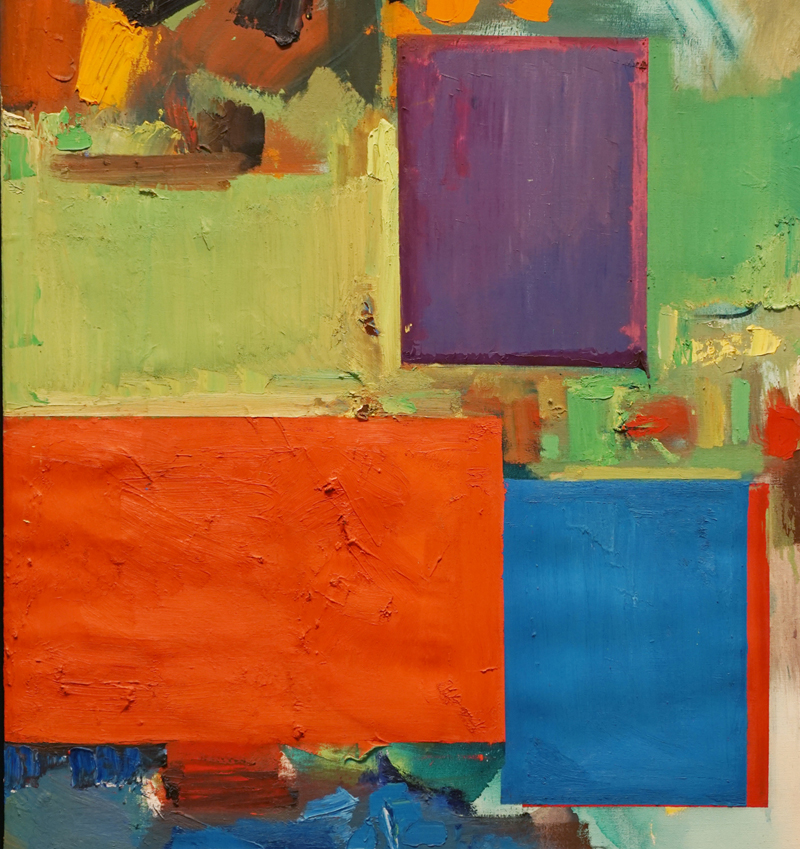 The way these two things are in this painting is more subtle than it might seem at first glance. You could think the rectangles are the logical part, and the strokes and patches are the free part. But on closer looking, you can see that the three orderly rectangles have vaguenesses, irregularities, and freedom, too. The red-orange one spills out of its edge at the bottom, near the middle, and blends into the roughly painted blue area below. To the right, a blue rectangle exactly the same height as the red one is dropped and suspended in a light space. We feel something like gravity and floating simultaneously.
The way these two things are in this painting is more subtle than it might seem at first glance. You could think the rectangles are the logical part, and the strokes and patches are the free part. But on closer looking, you can see that the three orderly rectangles have vaguenesses, irregularities, and freedom, too. The red-orange one spills out of its edge at the bottom, near the middle, and blends into the roughly painted blue area below. To the right, a blue rectangle exactly the same height as the red one is dropped and suspended in a light space. We feel something like gravity and floating simultaneously.
Also, this blue rectangle seems as if it might have another red one in back of it—with the right side showing and just a bit of the bottom underneath. It’s not just a single, neat rectangle, all by itself. There is also a line of pale green at the top—this seems to both accent the edge of the blue rectangle at the top, and also lift it.
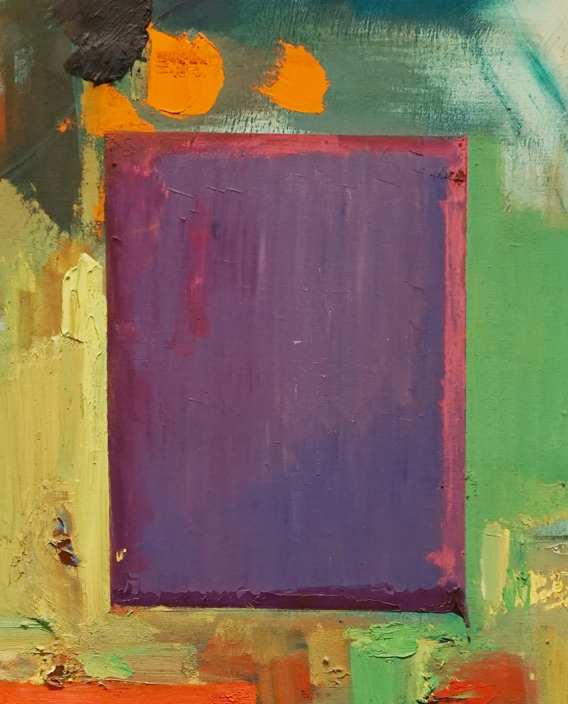 To me, the purple rectangle above is the most beautiful of all. It seems fixed and floating at once. Its edge is precisely defined and exact, but on the right and left sides, where purple meets green and yellow, the color shimmers a bit, there is something subtly “unrestricted, uncontrolled.” Its singularity and its purple color give it a regal quality, but inside cool violet plays against warm violet. And at the bottom right corner, this very precise rectangle drips a little.
To me, the purple rectangle above is the most beautiful of all. It seems fixed and floating at once. Its edge is precisely defined and exact, but on the right and left sides, where purple meets green and yellow, the color shimmers a bit, there is something subtly “unrestricted, uncontrolled.” Its singularity and its purple color give it a regal quality, but inside cool violet plays against warm violet. And at the bottom right corner, this very precise rectangle drips a little.
There are three energetic orange dabs above, and the left one meets the purple rectangle at its corner. There, it infuses some orange into the band of color that forms a border around the purple. So freedom and order, meeting at the right angle, make for gaiety. Hofmann also has patches of sober color—brown and black—floating even higher than the orange dabs. These dark colors get an exuberance from their placement high up.
In this painting where three rectangles are so predominant, there is also a lovely curved feeling, an exuberant sweep at the top. A dark green seems to emerge from behind the brown and black patches, sweeps across and then upwards—the strokes seem lighter, the paint less thick. It’s got something of the feeling of a wave at the beach and the spray. A wave and rectangles—that’s how I want to be: orderly and free.
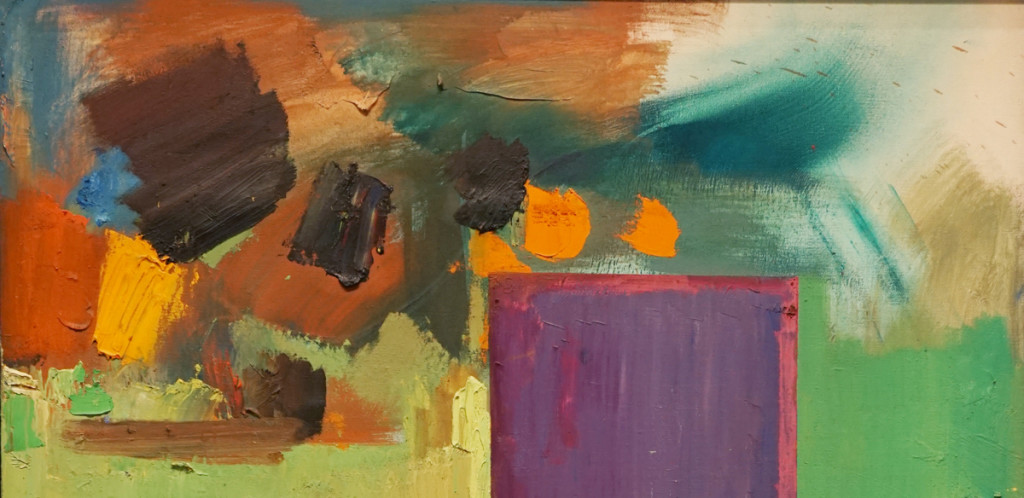 Hans Hofmann painted “Rhapsody” when he was 84. It affected me to learn that he was a student of math and science when he was young, and he even invented a scientific measuring instrument: the electromagnetic comptometer. Critic Erle Loran, writing of Hofmann’s work, points to exuberance and good sense. He describes the “boldness…of his color,” the “ferocious energy” and the “daring to let go,” and yet says “there is always and inevitably a sound idea in everything he paints.”
Hans Hofmann painted “Rhapsody” when he was 84. It affected me to learn that he was a student of math and science when he was young, and he even invented a scientific measuring instrument: the electromagnetic comptometer. Critic Erle Loran, writing of Hofmann’s work, points to exuberance and good sense. He describes the “boldness…of his color,” the “ferocious energy” and the “daring to let go,” and yet says “there is always and inevitably a sound idea in everything he paints.”
Exuberance That Arises from Weight, Depth, Logic
The brilliance and exuberance of color in Hans Hofmann’s painting come from ideas and a state of mind that had weight and solidity. This is not gushy emotion that is on top, exuberance that is devoid of logic and reason. That is what I was afraid of as a person—if I was really exuberant, I thought I would be insincere and mindless. Hofmann says no—what is bright, exuberant and on the surface arises from weight, depth, logic.
Through my study of Aesthetic Realism, the way I saw the whole world changed, enabling me to be honestly excited, stirred by things in a way I never was before. I am both a more truly exuberant and a more sensible man.
Eli Siegel saw that a painting, a person—the entire world—has a solid structure you can count on for all time: the oneness of opposites. Learning this frees a person to feel completely sensible at the very same moment that he’s swept by reality. This education is true about beauty, about us, about the world—and I am so glad that people across the country are learning about it.